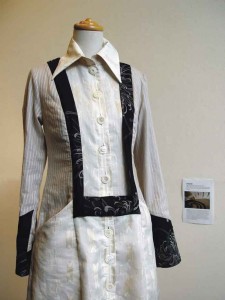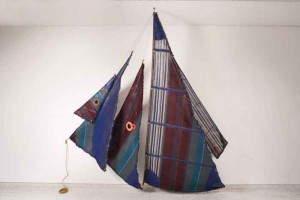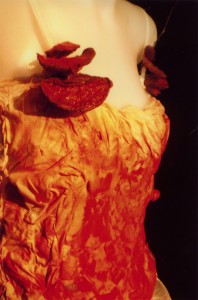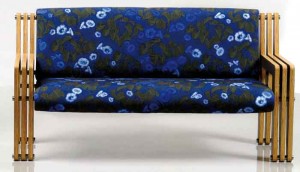A single connecting thread winds through 300 years of textile and computing history. Without the warp and weft of textile technology, the hardware and software that enable today’s ubiquitous information processing revolution would never have emerged.
In the early 21st century the newest hybrid artforms of embedded computing and wearable technology are generating creations that would, until only recently, be beyond imagination. The artists below like many creatives today, work seamlessly across art, fashion and design.
This blurring of delineated arenas of practice, and the entwining of the latest technologies into established realms is not new. The artists we see in the Coded Cloth Exhibition all utilise traditional textile practices such as weaving, stitching, embroidery, printing and dyeing; however the different electro-mechanical or biological properties of their materials produce aesthetically charming and complex works which have both practical properties and surprising functionality.
Elliat Rich’s elegantly designed reactive furniture piece, the Yala Sofa, quite literally blossoms into life when touched by the warmth of humans. Rich beautifully illustrates her philosophy of designing sustainable “objects that celebrate the poetry of humble pleasures”.
Exquisite tailoring hides a high tech secret in an elegant dress jacket by Newcastle fashion designers High Tea with Mrs. Woo. The sisters describe their travel wear for the 21st century woman as “fashion with secret powers…prepared and invincible”.
Santoro’s five-meter Sonic Sails gallery installation is, quite literally, a ship that sails on a swell of sound. As the cassette tape retains its magnetic quality through the weaving process, Alyce has “created a fabric with sounds sacred sounds woven into it”.
In what may seem like a science fiction scenario, bio artist Donna Franklin has created a living garment – a dress that grows! The glowing and seemingly floating hybrid Fibre Reactive dress challenges us to consider how we as a society commodify and manipulate other living entities, and how that will manifest in the not to distant future through the physical and cultural impact of biotechnology.
Each marvellously intricate and unique artwork in Coded Cloth seamlessly combines tradition skills with innovation and creativity, to express the philosophies and personality of the creator. These embedded electronics, interactive textiles, encoded and living fabrics produce a surprising, astounding and inspirational glimpse into our coded future, while highlighting an integrated approach to art, design, sustainability, community and culture.
‘HIDDEN’ – High Tea With Mrs Woo
Hidden is a shirt-dress that combines fashion and functionality. Inspired by travel, its design explores the appealing idea of feminine travel-wear with the useful feature of built-in heating pockets. Invisible warmth has been achieved by seamlessly integrating electronics into the garments construction. At the current stage of the project, the soft switch and circuitry has been designed to be washable and the belt to be a removable, rechargeable battery pack. There is potential for the design to be entirely washable with new waterproof innovations and technology available today.
The simple idea of “invisible warmth” was not easy to achieve. Although our aim was to use technology to create warmth, we found ourselves asking, is it necessary to use electronics and create energy to do this? Pockets could be heated simply by the choice of any warm material, like fleece or wool. Also, existing pocket warmer products would solve all our original design issues – washable, detachable, convenient, invisible, and re-usable. So was it just a novelty to create a pocket-warming dress with conductive textiles and electronics? Is it just another invention of useful uselessness?
High Tea With Mrs Woo
High Tea With Mrs Woo is the design collaboration of three sisters – Rowena, Juliana & Angela Foong. They make garments and objects that are charming, thoughtful and everlasting. They explore nostalgia and romantic escape by recapturing journeys and translating tales into contemporary wearable inventions.
‘Fabric of sound’ - Alyce Santoro
Many years ago, when it first occurred to me to literally weave a fabric made of sound, I began by knitting with cassette tape.With the help of a textile artist I knew, knitting soon gave way to weaving using tape as weft and cotton thread as warp. The resulting material was quite surprising. It felt like a light canvas, but had a beautiful, mysterious sheen and not at all like the loose web I had been getting by knitting. I called it sonic fabric.
A short while later I moved to New York City and brought along the two original panels of fabric I had made from 100 individual tapes. I planned to silkscreen a pattern onto them and show them as a series called The Tell-Tail Thankgas (tell-tails = wind indicators used on sailboats, thankgas = Tibetan scroll paintings) as part of my body of conceptual artwork. Upon arrival in New York, the sonic fabric panels began to cause an unexpected stir. One acquaintance suggested I take apart an old cassette deck, run the tape head along the fabric’s surface and see if it would emit sound. Excitingly, since the tape’s magnetic properties are maintained throughout the weaving process, the fabric actually was audible . Jon Fishman, percussionist for the band Phish, heard about the project and asked if I could make him a “rhythm suit” that he could wear and play on stage, woven from his personal collection of tapes.
Suddenly, I was faced with the challenge of making more fabric.I sought out two different opportunities. Firstly, in wanting to give back to the Tibetan Buddhist culture that had partly inspired the project, I enlisted the aid of hand-weavers at a craft cooperative for Tibetan women refugees in Nepal. Secondly and simultaneously, a fashion designer I knew recommended I use a small textile mill near Providence that specialized in working with unusual materials.
Dennis Lafond at the J. C. Lafond Company was immediately receptive to attempt making these samples. Feeling extremely optimistic about the potential of such a unique textile, he took a sincere personal interest in the project and went to extraordinary lengths to make it happen. While other small New England textile mills were going out of business all around him, Dennis persisted. He salvaged an old loom with a specialized shuttle able to pick up the audiotape with the exact amount of delicate pressure required . It is due to Dennis’ enthusiasm and dedication that sonic fabric is now available by the yard.
For certain projects, I hope to be able to continue working with the hand weavers in Nepal, and look forward to the opportunity to visit the craft coop there. Like Tibetan prayer flags, the work I’ve made from sonic fabric is truly intended to radiate the good vibrations it contains out into the world. As the collages of sounds recorded onto the audiotapes are one wonderful aspect of this work, the people who have nurtured, inspired, and continue to support sonic fabric have made it a truly worthwhile journey.
Alyce Santoro
Alyce Santoro is a conceptual and sound artist with a background in biology and scientific illustration. Her “philosoprops” and “subtle reality technologies” are all part of a grand multi-media, multi-disciplinary experiment into the mystery inherent in the natural world. Alyce is a post-urban pioneer in the high desert of west Texas.
‘FIBRE REACTIVE’ – DONNA FRANKLIN
Imagine clothing that grows with you.
The piece Fibre Reactive is uniquely a living garment. By its very existence, the dress raises debate around the contentious manipulation of living entities as a commodity; nature as a new interface. As all artists use different artistic tools, this work uses microbiology.
Fibre Reactive is made of the fungi Pycnoporus coccineus, otherwise known as orange bracket fungus. The mycelium of the organism has been grown to produce its living surface. The orange hue produced is an adaptation of the organism’s fruiting body stage. It occurs due to the impact of artificial manipulation within the laboratory; re-locating the fungi into a new pseudo-environment. The dress is initially supplied with nutrients that replicate its needs within its natural environment, thus rendering it reliant on technology and human intervention to now survive.
New technologies greatly impact cultural construction. They rapidly shape our understanding of reality, identity and interaction with the environment. It is therefore important for cultural practitioners and theorists to debate the consequences and evaluate these potential futures, as they will inevitably impact our sociological and cultural awareness.
Our relationship to technology can be described as ‘ the “post human” condition, where the products such as make-up and surgery, drugs, mobile telephones’ have become so ingrained into our everyday lives that they become ‘technological extensions of our biological bodies’ . We are so comfortable and familiar with these technologies that they have ‘become normalised’ . The development of biotechnologies is what takes technological integration beyond the mere mechanical, to a more primal level.
As a species, humans have separated themselves from the immediate experience of the natural world with technology. Through intervention we have constructed a “cultured” experience of nature. This mediated experience, manifested by cultural industries, can create a disassociation with the origin of the raw materials. Fibre Reactive confronts the viewer with the physical actuality and visceral experience of a living garment through the juxtaposition of the familiar with the “alien”.
It is the intention of this work to rupture the meaning of garments and their role in commodity culture, and instead draw attention to our own mortality. Could a living dress be dangerous? Could it consume the human body? Or could the human body consume the dress?
Donna Franklin
Donna has collaborated in various projects working with technologies of microbiology. Using performance, installation and film the projects develop themes such as commodified bodies/organisms and art/science dynamics. She is currently a tutor in Cultural History and Theory at the School of Communications and Arts, Faculty of Education and Arts, ECU.
‘Celebrating coming together in the comfort zone’ – Elliat Rich
Yala Sofa is a furniture piece that blossoms in the company of others. Based on the concept of Ipomoea, a plant that grows throughout the central deserts of Australia, Yala Sofa provides an inspiring space for people to come together. Using a thermochromatic ink, the Ipomoea flowers remain invisible until the heat from the bodies of those sitting on the sofa activates the ink and the flowers are revealed.
The Ipomoea plant, otherwise known as Bush Potato or Yala by Pintupi people, provides a rich source of bush food for those who live in harsh conditions in the central desert. A potato-like tuber grows in the roots of the plant, and digging these up is an opportunity for socialising. The Yala plant flowers after desert rains.
Elliat Rich
Elliat Rich is a multi-disciplinary designer based in Alice Springs, Australia. Elliat completed her Bachelor of Design at the College of Fine Arts, UNSW with first-class honours in 2005. Before, during and after her degree, Elliat travelled extensively throughout rural and remote Australia, both by road and on foot with teams of pack animals. Her work is shown both nationally and internationally. She recently finished working as a designer for The Centre for Appropriate Technology in Alice Springs and now runs her own design studio. She works on client-driven and commissioned based projects as well as self-directed object design projects concerned, in their broadest sense, with sustainability.
Acknowledgements
Excerpt from the Coded Cloth Catalogue Essay, by Dr Melinda Rackham, Executive Director of the Australian Network of Art and Technology. Reprinted with permission from the Samstag Museum of Art, University of South Australia.
Read More
http://www.highteawithmrswoo.com.au
Watch More
 This work is licensed under a Creative Commons Attribution-NonCommercial-ShareAlike 2.5 Australia.
This work is licensed under a Creative Commons Attribution-NonCommercial-ShareAlike 2.5 Australia.










